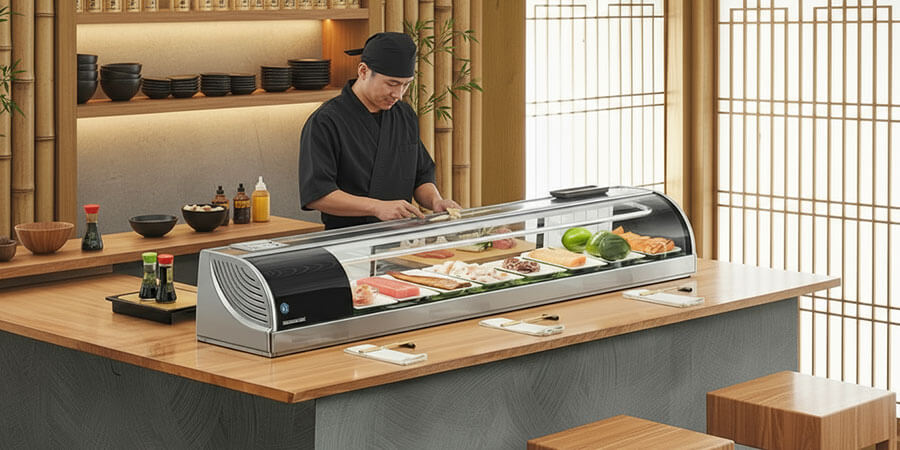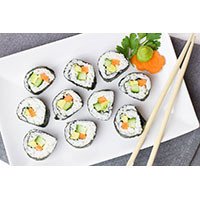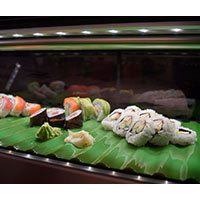Sushi Display Case Guide

Table of Contents
Essential equipment for fresh sushi presentation and restaurant operations
Commercial sushi display cases are specialized refrigeration units designed specifically for showcasing fresh sushi and seafood in restaurant environments. Unlike standard refrigerators, these display cases maintain precise temperatures while providing clear visibility for customer appeal. From left mount to right mount configurations, this comprehensive guide covers everything operators need to select, maintain, and optimize sushi display equipment for restaurants, catering operations, and foodservice establishments. Whether you're managing a sushi bar, Japanese restaurant, or seafood buffet, the right display case ensures food safety compliance, product quality, and operational efficiency while meeting rigorous health department standards.
The Business Case for Commercial Sushi Display Cases
Why Restaurants Need Professional Sushi Display Equipment

Commercial sushi display cases are essential investments for any restaurant serving fresh sushi or seafood where product visibility, temperature control, and presentation quality are critical priorities. Unlike standard refrigeration, these specialized units maintain precise temperatures (32-41°F/0-5°C) while providing optimal display conditions for sushi and garnishes.
Important Note: Sushi display cases are designed for display purposes during business hours only. They are not suitable for overnight storage of sushi or supplies, which should be kept in commercial refrigerators with proper insulation for extended temperature maintenance. These cases feature glass fronts for customer viewing with rear access doors for staff loading and maintenance.
Operational Excellence Benefits:
- Temperature Precision: Maintains sushi at optimal 32-41°F (0-5°C) to prevent bacterial growth and preserve quality
- Product Visibility: Clear glass construction allows customers to view fresh sushi and garnishes
- Display Optimization: Professional presentation increases perceived value and sales
- Safety Compliance: Meets FDA, USDA, and local health department requirements for raw seafood storage
- Staff Efficiency: Streamlined access and organization improve service speed and accuracy
Key Benefits for Restaurant Operations
Professional sushi display cases provide consistent temperature control (32-41°F/0-5°C) essential for food safety while offering clear product visibility that enhances customer appeal and drives sales.
Commercial Sushi Display Case Types & Applications
GoFoodservice categorizes commercial sushi display cases by mounting configuration, designed specifically for restaurant sushi display requirements.
1. Left Mount Sushi Display Cases

Compressor mounted on the left side for optimal right-handed chef access. Ideal for traditional restaurant layouts and right-handed operations.
Key Features:
- Compressor positioned for unobstructed right-side access
- Perfect for right-handed sushi chefs and standard service flows
- Works seamlessly in conventional kitchen configurations
- Maintains clear workspace on the right side for plating
Best Applications:
- Traditional sushi bars with right-handed primary chefs
- Restaurants following standard layout conventions
- High-volume operations requiring efficient right-side access
- Facilities with established right-handed workflow patterns
2. Right Mount Sushi Display Cases

Compressor mounted on the right side for optimal left-handed chef access. Suitable for alternative layouts and left-handed operations.
Key Features:
- Compressor positioned for unobstructed left-side access
- Designed for left-handed sushi chefs and unique service patterns
- Adapts to non-traditional kitchen floor plans
- Provides clear workspace on the left side for specialized plating
Best Applications:
- Restaurants with left-handed primary chefs
- Facilities with alternative or compact layout requirements
- Operations requiring left-side access patterns
- Modern establishments with innovative kitchen designs
Common Features for Both Types:
- Capacity: 8-16 sushi platters (96-192 pieces)
- Temperature range: 32-41°F (0-5°C)
- Stainless steel construction with tempered glass
- Digital temperature controls and monitoring
- Self-closing sliding glass doors
- LED lighting for optimal product visibility
Investment Scenarios by Restaurant Operation Type
Small Sushi Operation (50-100 seats):
- Equipment Cost: $3,000-$8,000 per case
- Best Fit: Single left or right mount case
Mid-Size Japanese Restaurant (100-200 seats):
- Equipment Cost: $6,000-$15,000 for multiple cases
- Best Fit: 2-3 display cases with optimal mounting
Large Buffet/Catering Operation (200+ servings/day):
- Equipment Cost: $12,000-$25,000+ for large systems
- Best Fit: Multiple large-capacity display cases
Selection Framework
Capacity Guidelines

Match display case capacity to your daily sushi production volume:
- Small operations (50-150 pieces/day): Single case with 96-192 piece capacity
- Medium restaurants (150-400 pieces/day): Dual cases with 192-384 piece capacity
- Large buffets/catering (400+ pieces/day): Multiple cases with 384+ piece capacity
Key Features & Specifications
Essential Selection Features
Capacity & Configuration:
- Match platter capacity to daily sushi production requirements
- Choose left mount or right mount based on chef access patterns and layout
- Consider sliding door configuration for optimal service workflow
- Evaluate floor space requirements and restaurant traffic patterns
Construction & Durability:
- Stainless steel construction for corrosion resistance and easy cleaning
- Tempered glass panels rated for restaurant heavy use
- Reinforced frames and mounting systems for stability
- NSF certification for food equipment safety standards
Temperature Control & Monitoring:
- Precise 32-41°F (0-5°C) temperature range for optimal sushi preservation
- Digital temperature displays and programmable controls
- Temperature alarms and logging capabilities for compliance
- Ambient temperature consideration for placement locations
Refrigeration System Options:
- Cold Wall Refrigeration: Evaporator coils integrated into cabinet walls, providing gentle, even cooling without fans. Ideal for maintaining consistent temperatures without affecting sushi quality or causing dehydration.
- Forced Air Refrigeration: Uses fans to circulate cold air throughout the display area, providing faster cooling and temperature recovery. Better for high-traffic environments requiring quick temperature stabilization after frequent door access.
Essential Accessories for Restaurant Operation
- Sushi Platters & Racks: Compatible display platforms and organizational systems
- Temperature Monitoring: Digital thermometers and data logging devices
- Cleaning Supplies: Food-safe sanitizers and glass cleaners
- Replacement Doors: Sliding glass door components and seals - doors are small, sliding units used by sushi chefs
- Lighting Systems: LED lighting for optimal product visibility
Door Care & Replacement Considerations
Sushi case doors are small, sliding glass panels used by chefs to access product during service. Common issues include cracking from dishwasher cleaning (never put glass doors in dishwashers) and front glass breakage from impact. When front glass breaks, unit replacement is often more cost-effective than repair due to sealing complexity. Always inspect for freight damage upon delivery and refuse damaged units due to the high glass content that makes shipping risky.
Installation & Maintenance
Professional Installation Requirements
Commercial sushi display cases require professional installation to ensure proper temperature control, electrical safety, and structural integrity in restaurant environments.
Installation Checklist:
- Professional electrical connection with dedicated 115V circuit
- Level installation on stable counter surface capable of supporting unit weight
- Adequate ventilation clearance (2-3 inches on sides and back, can be butted against adjacent equipment)
- Secure units to counter if multiple units are side-by-side or in high-traffic areas
- Condensate drainage setup if needed
- Temperature calibration and performance verification
- Staff training on operation and maintenance
Installation Cost Factors:
- Basic Setup: $400-$900 for electrical and basic connections
- Complex Electrical: $900-$1,800 for upgraded service or special requirements
- Counter Reinforcement: $300-$800 for securing multiple units or heavy-duty installations
- Professional Calibration: $250-$600 for initial setup and certification
Maintenance Schedules & Best Practices
Regular maintenance ensures consistent performance, temperature control, and compliance with health department standards in busy restaurant settings.
Daily Maintenance Procedures:
- Clean glass surfaces with food-safe cleaners and microfiber cloths
- Verify temperature readings and alarm functionality
- Inspect sliding door mechanisms and seals
- Check for proper platter alignment and display organization
- Empty and clean condensate drains as needed
- Document temperature readings for compliance records
Weekly Maintenance Tasks:
- Deep clean interior surfaces and stainless steel components
- Calibrate temperature controls and verify accuracy
- Inspect door tracks and sliding mechanisms for wear
- Clean condenser coils and verify proper airflow
- Test lighting systems and replace bulbs as needed
- Rotate sushi inventory using FIFO (First In, First Out) principles
Monthly Professional Service:
- Complete system diagnostics and performance testing
- Clean and maintain refrigeration components
- Calibrate temperature sensors and monitoring systems
- Inspect electrical connections and safety systems
- Update software and firmware as manufacturer recommends
- Comprehensive cleaning of hard-to-reach components
Troubleshooting
Common Issues & Solutions
Temperature Control Problems:
- Temperature Too High: Check door seals for proper closure, clean condenser coils of dust and debris, verify thermostat calibration with a certified technician, and ensure adequate ventilation around the unit
- Temperature Fluctuations: Ensure the case is level and stable, minimize door openings during peak periods, clean air vents and filters regularly, and check for ambient temperature variations in the restaurant
- Inconsistent Readings: Calibrate temperature sensors professionally, check electrical connections for loose wires, replace faulty digital displays, and verify the refrigeration system's performance
Door & Access Problems:
- Sticking Doors: Clean door tracks and rollers with food-safe cleaners, lubricate sliding mechanisms with manufacturer-approved lubricants, and replace worn rollers or damaged tracks
- Cracked Glass: Never attempt DIY repairs on glass components - contact a professional technician for complete door assembly replacement to maintain temperature integrity
- Poor Seals: Replace worn door gaskets with OEM parts, ensure proper door alignment and closure, and check for frame damage that could affect sealing
Performance & Maintenance Issues:
- Excessive Frost Buildup: Clean and replace door gaskets if damaged, check defrost cycle timing and operation, ensure proper ventilation clearance, and verify refrigerant charge levels
- Unusual Noises: Inspect fan motors for damage or imbalance, check component alignment and mounting, tighten any loose parts, and listen for refrigerant flow issues
- Lighting Problems: Check electrical connections at the LED assemblies, replace faulty LED components with compatible parts, and verify voltage at the light circuit
Display & Operational Challenges:
- Product Drying: Choose Cold Wall refrigeration systems for gentle cooling, minimize door openings by organizing workflow efficiently, maintain consistent humidity levels, and rotate product frequently
- Condensation Issues: Ensure proper condensate drainage setup, check ambient temperature and humidity in the display area, verify door seals are intact, and consider placement away from heat sources
- Peak Period Management: Pre-position frequently ordered items at accessible locations, establish clear service protocols for door usage, and train staff on efficient product retrieval techniques
Frequently Asked Questions
What temperature should sushi be stored in display cases?
Sushi should be maintained at 32-41°F (0-5°C) to prevent bacterial growth while preserving quality. Commercial sushi display cases are designed to maintain this precise temperature range consistently, with monitoring systems to ensure compliance with FDA and health department standards.
How often should sushi display cases be cleaned?
Daily surface cleaning and weekly deep cleaning are essential. Monthly professional servicing should include condenser cleaning, temperature calibration, and system diagnostics. Regular cleaning prevents bacterial growth and ensures optimal performance.
What's the difference between left mount and right mount sushi cases?
Left mount cases have the compressor on the left side, providing optimal access for right-handed chefs. Right mount cases position the compressor on the right side, providing optimal access for left-handed chefs. The choice depends on your primary chef's handedness and restaurant layout.
How much does a commercial sushi display case cost?
Single cases range from $3,000-$8,000, dual cases cost $6,000-$15,000, and large systems can exceed $20,000. Costs vary based on capacity, construction quality, and features. Consider total cost of ownership including installation and maintenance.
What size sushi display case do I need for my restaurant?
For 50-150 pieces daily, plan for 96-192 piece capacity. For 150-400 pieces, consider 192-384 pieces. For 400+ pieces, 384-768 pieces or more. Factor in peak usage periods and consider 25-40% buffer capacity for special events.
Are sushi display cases suitable for overnight storage?
No, sushi display cases are designed for display purposes during business hours, not overnight storage. Sushi should be stored in commercial refrigerators at proper temperatures (32-41°F) for extended periods. Display cases lack the insulation and temperature stability needed for prolonged storage.
What should I do if the glass door cracks?
Glass door replacement is complex and often requires professional service. Contact your equipment supplier or authorized technician for proper replacement. Do not attempt DIY repairs, as improper installation can compromise temperature control and safety.
How do I prevent sushi from drying out in the display case?
Use Cold Wall refrigeration systems, minimize door openings, maintain consistent temperatures, and consider humidity control. Avoid Forced Air systems for delicate sushi that can dry out quickly.
What maintenance is required for sushi case doors?
Clean tracks weekly, lubricate sliding mechanisms monthly, and replace worn components promptly. Never put doors in the dishwasher, as the heat can cause cracking. Professional door replacement is recommended for damaged components.
How can I minimize transit damage to glass components?
Always inspect the unit upon delivery and refuse damaged shipments. Glass components are fragile and often sustain damage during shipping. Document any damage immediately and work with the carrier for resolution rather than accepting and repairing later.
Shop Related Products:
- Refrigerated Sushi Cases
- Sushi Case & Tapa Case Parts
- Commercial Refrigeration
- Sushi Making Tools
- Sushi Servingware
- Bento Boxes
- Commercial Rice Cookers
- Asian Sauces & Glazes
Related Guides:
- Commercial Kitchen Steam Equipment Guide
- Commercial Cooking Equipment Guide
- The Ultimate Commercial Kitchen Equipment Checklist
Share This!